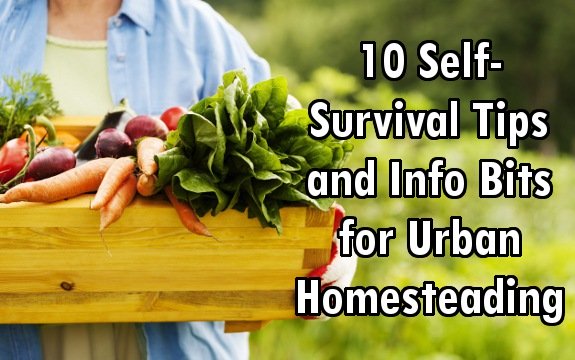10 Self-Survival Tips and Info Bits for Urban Homesteading

 You don’t have to live in a rural area to enjoy the fruits of your own labor. Many people in the suburbs and cities are learning how to homestead (live a lifestyle of self-sufficiency) without ever leaving their cities.
You don’t have to live in a rural area to enjoy the fruits of your own labor. Many people in the suburbs and cities are learning how to homestead (live a lifestyle of self-sufficiency) without ever leaving their cities.
If growing 3 tons of organic produce annually on your 4000 square foot lawn sounds good to you, or learning how to plant a bee garden sounds good to you, then read on. Urban homesteading offers a more sovereign life, even if you don’t live on a ranch or farm.
Here are 10 great tips for homesteading, paving way for a more self-sustaining, live-free lifestyle.
- 1. There are so many sites providing excellent tips for people who want to grow their own food, learn how to can peaches for the first time, save the Monarch butterflies by planting herbs and flowers they love, or plant their own miniature fruit trees. Mother Earth News, for example, promotes organic gardening and homestead living for people of all walks of life. You can learn how to grow pole beans in coffee cans, churn your own butter or even turn a patch of dry dirt by your mailbox into a microgreens garden, out of which you harvest your dinner salad as you fetch your electric bill from the box. I love this site. It’s an absolute library on homestead living.
- 2. You can start a garden in your kitchen. This site tells you how to start seedlings, transplant them, put them in pots or a small garden, and more.
- 3. If you are going to grow your own food, you need to know how to save it. After all, a bumper crop of apples, or a whole lot of onions can’t all be eaten at once. This is why people learned to can, freeze-dry, and dehydrate foods so they could be eaten over longer periods of time. Pickyourown.org tells you all about ways to save your food – and lower your grocery bills tremendously. Who wouldn’t want some tasty canned peach pie or strawberry-rhubarb jam, organic and GMO-free, made in your own kitchen? Delicious. It’s easier to do these things than you think, and there are several different techniques you can try.
Read: 5 Foods You can Grow from Organic, Store-Bought Produce
- 4. UrbanHomestead.org and the lazyhomesteader.com show people how a working micro-farm in the middle of a busy city works, literally a mile from the freeway, or how to build water catchment systems that are still within city codes.
- 5. Good homesteaders have gotten so good at urban homestead living, that they sell their surplus produce to local farmer’s markets or give it to food pantries.
- 6. Seasoned urban homesteaders teach you how to compost kitchen scraps. Backyard food composting is as easy as getting some good bins with some composting worms, or burying your scraps in a pre-dug hole.
- 7. Would you like to be a beekeeper in the middle of a growing suburb? No problem. There are even homesteaders who bee-keep in the middle of Brooklyn on rooftops. These satellite bee-keeping individuals help plants get pollinated.
- 8. Homesteaders can also teach you about joining an organic food co-op to get more good food for less. It’s a great way to start to dip your toes into the self-sovereign movement that is sweeping the US.
- 9. There are organic soil amendments that can help fix old, tired, pesticide-laden lawns and help prepare urban and suburban land for growing. This site tells you more than you’d ever need to know.
- 10. If you really have no space to start a growing project, you can also find community gardens. Community gardens encourage an urban community’s food security, allowing people to grow their own food. They bring urban gardeners closer in touch with the source of their food, and break down social isolation by encouraging community interaction.

Check out a lot of great gardening information on youtube by searching Ali Reynolds. She also has her own web site where you can order some amazing garden amendment/additions. We are going to try the Three Sisters this year. Sounds delightful.
There is just a wealth of great information at her web site (link below) too, even though her spelling, grammar and a few typo’s leave something to be desired. 😉
Each of the three articles included at the link (keep scrolling) has MUCH information about soil amendments, even if you’re not using compost (despite the title on the link). For instance, I did not know that perlite only had to be added to soil every five to seven years, and peat only needs to be added every four years. There are lots of other interesting things on this page, as well. At the bottom of each of the three articles on this page, there are specific links, as well as those embedded within the articles.
Having a Victory Garden on your front lawn in Flori-dah, is not allowed in most areas of the state.